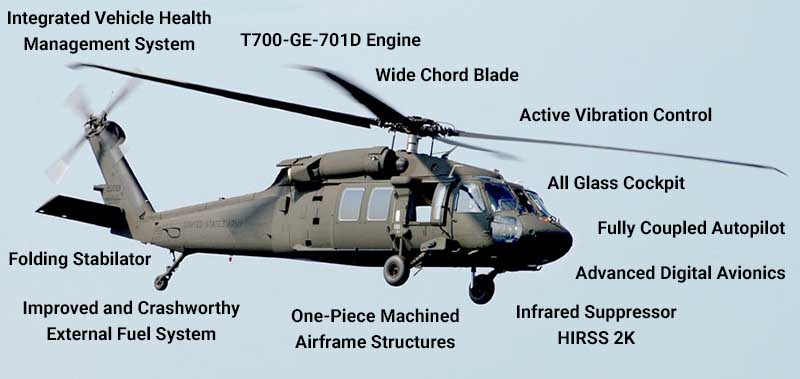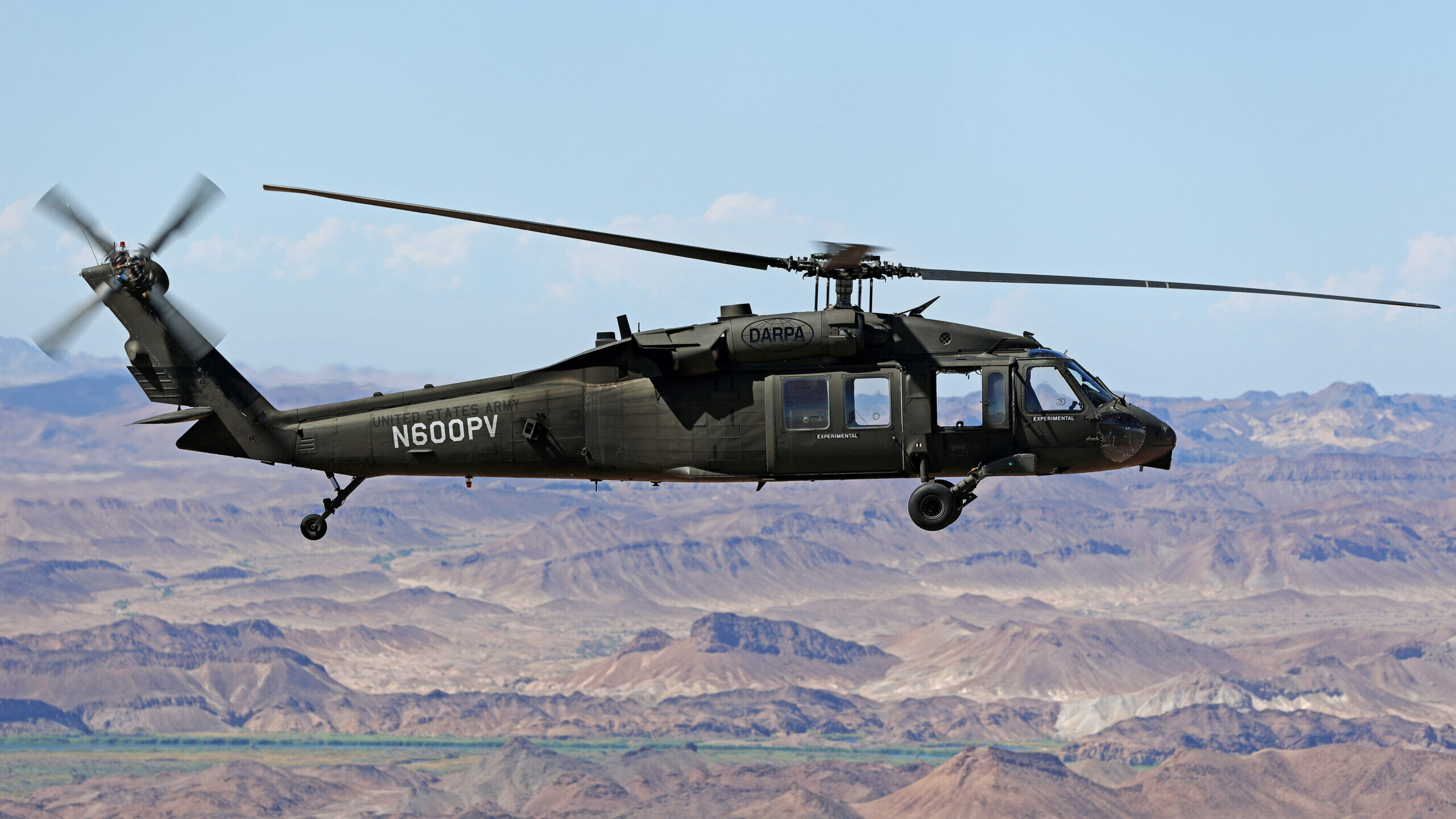Discovering the Convenience of the UH 60 in Different Military and Noncombatant Functions
Discovering the Convenience of the UH 60 in Different Military and Noncombatant Functions
Blog Article
UH-60: Technologies in Modern Helicopter Layout
The UH-60 helicopter stands as a benchmark in modern aviation, showcasing substantial advancements in style and innovation that deal with the progressing demands of military procedures. Its consolidation of innovative materials not just improves efficiency yet likewise addresses critical security issues. The assimilation of advanced avionics has actually transformed functional capabilities, permitting for greater situational understanding and decision-making performance. As we discover the advancement and vital innovations of the UH-60, it comes to be necessary to think about exactly how these growths affect not only existing applications but also the future landscape of helicopter style.

Development of the UH-60
The evolution of the UH-60 Black Hawk helicopter stands for a significant turning point in aerospace design and armed forces aeronautics. Presented in the late 1970s, the UH-60 was developed by Sikorsky Airplane to fulfill the United States Military's need for a versatile energy helicopter efficient in doing a range of objectives. Its layout emphasized maneuverability, rate, and resilience, setting new requirements for functional efficiency.
The UH-60 includes an unique four-blade rotor system, which enhances lift and stability, allowing it to operate effectively in varied environments. Its airframe is built from advanced composite products, contributing to a reduction in weight while keeping structural stability. The helicopter's layout additionally integrates enhanced the rules of aerodynamics, which enhances gas effectiveness and enhances variety.
For many years, the Black Hawk has undertaken multiple upgrades to improve its capacities, consisting of enhanced engines, advanced trip control systems, and modular systems for simple upkeep and flexibility. The helicopter's ability to do missions ranging from troop transportation to clinical emptying has strengthened its role as a backbone of U.S. army operations. The UH-60 Black Hawk continues to be a prime instance of just how advancement in helicopter style can considerably influence army efficiency and functional versatility.
Advanced Avionics Solutions
Advancements in avionics systems have actually transformed the capacities of modern-day helicopters like the UH-60 Black Hawk, improving functional effectiveness and situational understanding (UH 60). The integration of sophisticated avionics permits improved flight, navigation, and communication management, making the UH-60 much more flexible in diverse mission accounts
One of the crucial attributes is the innovative electronic cockpit, which uses multifunction displays that offer real-time information, guaranteeing pilots have immediate accessibility to vital trip info. This streamlining of information reduces pilot workload and enhances decision-making procedures during complicated procedures. In addition, the unification of GPS and inertial navigation systems makes it possible for accurate positioning and route preparation, enhancing goal execution in tough environments.
Furthermore, progressed avionics systems enhance interaction capacities through protected data links and voice communication systems, allowing smooth coordination with ground pressures and other aircraft. The integration of automated flight control systems better adds to enhanced security and control, particularly in adverse climate condition or during low-altitude maneuvers.
Engine and Performance Enhancements
Engine performance in contemporary helicopters has taken a substantial jump onward, driven by developments that improve integrity, power, and performance. At the leading edge of these improvements is the fostering of more effective turboshaft engines, site here particularly those using sophisticated materials and technologies that make it possible for higher temperature level resistances and boosted drive abilities. The UH-60 Black Hawk, for circumstances, uses the T700-GE-701C engine, which features a dual-channel, full-authority digital engine control system. This system boosts efficiency while enhancing fuel intake and minimizing maintenance demands.
Furthermore, the assimilation of engine health and wellness tracking systems enables real-time diagnostics and anticipating upkeep, dramatically boosting operational reliability. These systems not just sharp crews to potential problems prior to they end up being crucial yet likewise assist in Home Page a lot more effective upkeep scheduling, consequently lowering downtime.

Materials and Structural Innovations
Current advancements in materials and structural style have actually transformed modern-day helicopter construction, boosting both efficiency and longevity. The introduction of innovative composite products, such as carbon fiber strengthened polymers, has significantly decreased weight while preserving architectural integrity. This shift not only enhances gas efficiency but additionally enhances payload ability, permitting helicopters like the UH-60 to execute even more diverse objectives.
In addition, technologies in light weight aluminum alloys and titanium elements have actually added to boosted resistance to deterioration and tiredness, expanding the life-span of crucial airframe aspects. The tactical use these materials has brought about a decrease in upkeep demands and improved total functional readiness.

In addition, the combination of computer-aided style (CAD) and additive production technologies has actually made it possible for a lot more intricate geometries and light-weight frameworks, optimizing the aerodynamic performance of helicopter designs. These developments facilitate quick prototyping and production, permitting makers to respond promptly to developing mission demands.
Security and Survivability Functions
Safety and survivability functions in modern helicopter style have actually ended up being paramount, mirroring the raising demands for mission efficiency in tough environments. The UH-60 Black Hawk, a noteworthy instance, integrates sophisticated modern technologies to boost crew and passenger defense.
The helicopter also uses a ballistic protection system, that includes armored crew seats and vital systems protecting, minimizing vulnerability to tiny arms fire and shrapnel. Enhanced situational recognition is attained via innovative avionics and sensor technologies, permitting pilots to identify and avoid risks effectively.
In addition, the integration of redundancy in critical systems-- such as dual engines and several trip control channels-- ensures continued operation even if one system stops working. The UH-60 is outfitted with advanced emergency flotation devices, enhancing survivability in water landings. Jointly, these attributes not just boost the safety and security of workers yet also enhance objective success prices in hostile settings, showing the dedication to quality in helicopter design.
Final Thought
The UH-60 helicopter represents a substantial improvement in contemporary aeronautics innovation, incorporating ingenious products, advanced avionics, and durable safety attributes. Its evolution shows a dedication to enhancing performance and functional efficiency while making sure pilot and staff survivability. The integration of his response light-weight compounds and progressed navigation systems highlights the helicopter's flexibility in various armed forces missions. Generally, the UH-60 offers as a benchmark for future advancements in helicopter layout, symbolizing durability and versatility in modern army procedures.
The UH-60 helicopter stands as a criteria in modern aeronautics, showcasing considerable improvements in design and modern technology that cater to the evolving needs of military procedures. As we check out the evolution and vital technologies of the UH-60, it ends up being important to take into consideration exactly how these growths influence not just current applications yet also the future landscape of helicopter style.
Presented in the late 1970s, the UH-60 was created by Sikorsky Airplane to satisfy the United States Military's demand for a versatile utility helicopter qualified of performing a selection of missions. The UH-60 Black Hawk stays a prime instance of how technology in helicopter layout can considerably affect armed forces effectiveness and operational adaptability.
In general, the UH-60 offers as a standard for future growths in helicopter style, personifying durability and convenience in contemporary army operations.
Report this page